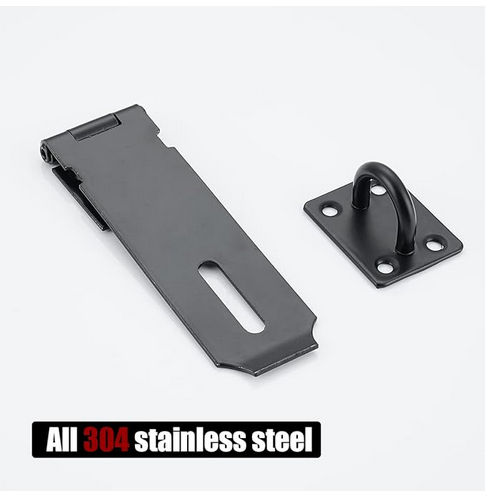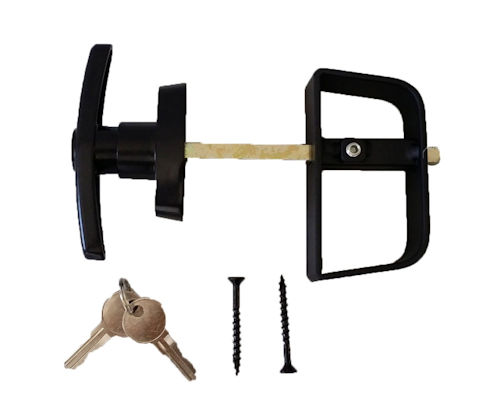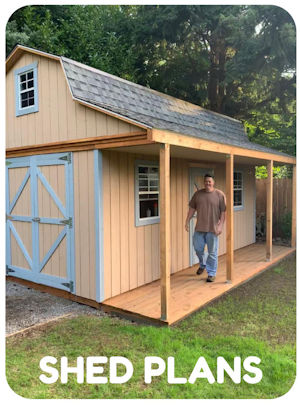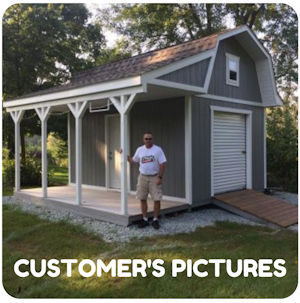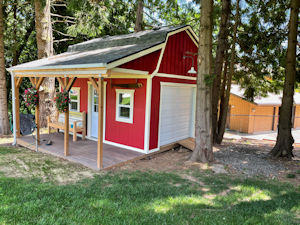Save 30% off Any Shed Plan Purchase!
Signup For My 'Shed n Sight' Newsletter
and Get Your 30% off Promo Code To Use At Checkout.
- Home
- Shed Door Hardware
- What's the best shed door lock?
Find the Best Shed Door Lock for Your Peace of Mind
When it comes to securing storage sheds, choosing the best shed door lock is crucial. As someone who has built many sheds over the years, I've tried out a variety of locks and latches. In this article, I'll share my experience and recommendations for the best shed door lock to keep your valuable tools and equipment safe.
Various types of locks for shed doors...
( Please note: some of the images contain affiliate links for purchasing. If you do purchase, I may make a small commission but this will not affect the price you pay!)
First, I'll talk about the different types of shed door locks available. The most common options for a shed door latch include padlocks, hasp and staple locks, rim locks, and T-handle locks. Each has its own pros and cons, which I will dive into.
Using padlocks for shed doors
Padlocks are some of the best locks and are a popular choice for shed security. They're affordable, easy to install, and come in a range of sizes and strengths. Look for a heavy-duty padlock made from hardened steel with a thick shackle that resists cutting. Opt for a closed shackle design for added protection against bolt cutters.
Master lock pro series
One of my favorite padlocks for shed doors is the Master Lock ProSeries. It's made from solid brass for weather resistance and has a 2-inch wide lock body for strength. The shackle is 3/8-inch diameter hardened boron alloy, making it extremely cut-resistant. This is a top choice for a secure padlock.
Use this lock on a hasp and staple lock for your shed door.
Pros and cons of using the Master Lock pro series lock
Before purchasing a Master Lock Pro Series lock for your shed door, consider these pros and cons in relation to your specific security needs and environment.
Pros:
1. Durability: The Master Lock Pro Series locks are made with robust materials that can withstand various weather conditions, prolonging their service life and maintaining security.
2. Security: These locks often feature advanced locking mechanisms, including high-security cylinders that are difficult to pick, drill or bump.
3. Shackles: Hardened boron alloy shackles offer improved resistance to cutting and sawing.
4. Weather Resistance: Many models come with weather covers or are designed to resist rust and corrosion, which is beneficial for outdoor use, such as on shed doors.
5. Versatility: They can be used for various applications, not just shed doors, offering flexibility in use.
6. Key Control: Some models offer key control options which can be essential for ensuring that keys are not easily duplicated without authorization.
Cons:
1. Cost: The high level of security and durability usually comes with a higher price tag compared to standard padlocks.
2. Weight: Master Lock Pro Series locks are often heavier and bulkier, which might be seen as cumbersome for some users or certain applications.
3. Maintenance: Despite their weather resistance, locks exposed to harsh environments might still require periodic maintenance such as lubrication to ensure they function smoothly.
4. Key Management: If you lose the key or have multiple locks keyed differently, it can become inconvenient to manage.
5. Complexity: The advanced features of these locks can make them more complicated to operate and maintain, particularly for users who prefer simplicity.
6. Compatibility: Depending on the specific design of the shed door hasps or latch, some Master Lock Pro Series locks may not fit perfectly.
Are hasp and staple locks good for shed door locks?
Hasp and staple locks are another option, consisting of a hinged metal hasp that fits over a metal staple, secured with a padlock. These work well for double shed doors. Look for a heavy-duty hasp made from thick steel with tamper-resistant screws and a weather-resistant finish. You'll also find that these come in different sizes. Don't get the smaller ones to save money. It's not worth it!
When installing a hasp, make sure to use long screws that go through the shed door and into the frame for a strong hold.
One of the best locks to use with the hasp and staple lock is the master pro series lock shown above.
Pros and cons of using a hasp and staple lock:
Pros:
1. Simplicity: Hasp and staple locks are straightforward to install and use, making them accessible for most people without requiring specialized tools or skills.
2. Affordability: Generally, these lock setups are cost-effective, making them a budget-friendly option for securing shed doors.
3. Flexibility: They can be used with a variety of padlocks, allowing you to choose the level of security that meets your needs.
4. Availability: Hasp and staple hardware is widely available and can be purchased at most hardware stores.
5. Customization: You can choose different styles and sizes of hasps and staples to suit your specific requirements.
6. Security Layers: When combined with a sturdy padlock, the hasp and staple setup can provide a good level of security, especially against casual theft attempts.
Cons:
1. Vulnerability: Standard hasp and staple setups may be more vulnerable to prying or cutting attacks compared to more advanced locking mechanisms.
2. Material Quality: Lower-quality hasps and staples can be prone to rust or deterioration over time, especially in outdoor environments.
3. Appearance: Some may find the look of a hasp and staple setup to be less aesthetically pleasing compared to more integrated locking solutions.
4. Installation: Improper installation can compromise the security of the lock. For maximum effectiveness, the hasp should cover the screws to prevent tampering.
5. Intrusiveness: The need to manually align and secure the hasp and staple each time can be less convenient than integrated locking mechanisms.
6. Padlock Quality: The overall security also heavily depends on the quality of the padlock used. A weak padlock can compromise the entire setup.
Overall, a hasp and staple lock setup offers a simple and cost-effective way to secure shed doors but may require careful consideration of the quality of both the hasp and the padlock to ensure adequate security.
What are Rim locks and are they any good?
Rim locks are a classic choice that mount on the inside surface of the shed door. They typically have a spring-loaded latch that catches on a strike plate mounted on the door frame.
Some rim locks can be locked with a key from the outside. While rim locks are a step up from a basic latch, they aren't the most secure option on their own. The latch can often be jimmied open with a credit card or screwdriver. I recommend pairing a rim lock with a heavy-duty padlock or adding a deadbolt for better security.
Pros and cons of using rim locks:
Pros:
1. Ease of Installation: Rim locks are generally easier to install compared to mortise locks since they are mounted on the surface of the door, requiring less precise cutting and fitting.
2. Affordability: Rim locks can be relatively inexpensive, making them a budget-friendly option for securing shed doors.
3. Traditional Look: For those who appreciate a vintage or rustic aesthetic, rim locks offer a classic look that can complement certain styles of sheds.
4. Accessibility: They are widely available and can be found in most hardware stores.
5. Convenience: Some rim locks come with integrated handles or knobs, making them easy to operate.
6. Versatility: Suitable for both inward and outward opening doors, offering flexibility in installation.
Cons:
1. Security: Rim locks are generally less secure than other options like deadbolts or high-quality padlocks. They can be easier to force open or tamper with.
2. Exposure: Because rim locks are surface-mounted, they are more exposed to weather conditions and physical attacks, which can lead to faster wear and tear.
3. Strength: They may not be as sturdy as other more robust locking mechanisms, potentially making them less effective against determined intruders.
4. Key Management: Some rim locks use skeleton keys, which can be less secure and more cumbersome to manage than modern keys.
5. Internal Components: Cheaper rim locks may have internal components that wear out more quickly, decreasing their longevity and reliability.
6. Compatibility: Depending on the construction of your shed door, a rim lock might not fit as well or provide as strong a hold as other types of locks.
In summary, while rim locks can offer a convenient and cost-effective solution for securing shed doors, they may not provide the highest level of security, especially against determined intruders or adverse weather conditions. It's important to weigh these factors based on your specific needs and the environment in which your shed is located.
The best shed door lock?...Here's my favorite!
https://shop.shedwindowsandmore.com/t-handle-lock/?aff=4
My best recommendation and what I feel is the best option for shed door handles with locks would be T-handle and L-handle locks. They are a convenient option that combine a lock and door handle in one. They install into a hole drilled in the shed door and are very easy to install!
Look for a T-handle lock made from die-cast zinc or stainless steel for durability. Some models come with a built-in padlock loop for added security. Just keep in mind that the lock cylinder is exposed, so it could potentially be picked or drilled out.
What are the pros and cons of using a T-handle lock:
Pros:
1. Enhanced Security: T-handle locks are generally more secure than simple padlocks or rim locks. They often feature a robust locking mechanism that is difficult to tamper with.
2. Durability: These locks are typically crafted from strong, weather-resistant materials, making them suitable for outdoor use and able to withstand adverse conditions.
3. Clean Appearance: T-handle locks offer a sleek and integrated look, which can be more visually appealing compared to exposed padlocks or bulky hasp setups.
4. Ease of Use: T-handle locks are often designed for quick and easy operation. Turning the handle engages or disengages the lock, providing straightforward access.
5. Built-in Mechanism: Since the locking mechanism is built into the handle, there is no need for additional padlocks or external components, reducing clutter and complexity.
6. Tamper Resistance: Many T-handle locks are designed to be tamper-resistant, incorporating features that make them harder to pry open or cut through.
Cons:
1. Cost: T-handle locks can be more expensive than simpler locking solutions like padlocks and hasps due to their integrated design and added security features.
2. Installation: Installing a T-handle lock may require more effort and precision, especially if your shed door needs modifications to accommodate the lock.
3. Compatibility*: Not all shed doors are designed to accommodate T-handle locks. Ensuring a proper fit might require additional hardware or alterations.
4. Key Management: If the T-handle lock uses a unique key, losing the key could pose difficulties, and getting replacements might be more cumbersome compared to standard keys.
5. Maintenance: While durable, the lock's moving parts may still require occasional maintenance, such as lubrication, to ensure smooth operation over time.
6. Limited Variety: T-handle locks have fewer style and finish options compared to other lock types, which might limit your aesthetic choices.
In summary, T-handle locks provide a secure and visually appealing option for shed doors but may come with higher costs and installation requirements. Consider these factors in relation to your security needs and the design of your shed door.
If your shed has pre-hung doors..
Most exterior pre-hung doors come with 2 holes pre-drilled in them. The top hole is for a deadbolt lock and the bottom hole is for a locking handle. Deadbolt locks offer a high level of shed security when paired with the locking lower handle. They have a thick steel bolt that slides into the door frame, making them very difficult to force open. Deadbolts need to be mounted on a solid door for maximum strength.
When choosing a deadbolt for your shed, look for one with an ANSI Grade 1 or 2 rating. These grades indicate the lock has passed rigorous testing for strength and durability. A Grade 1 lock can withstand 10 strikes of 75 pounds and a Grade 2 lock can take 5 strikes of 75 pounds.
What about locks for double shed doors
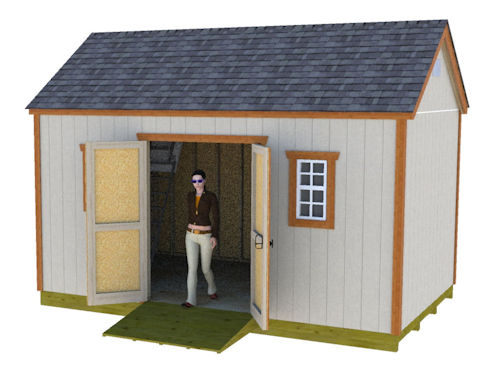 I Like T-handle Locks for Double Shed Doors!
I Like T-handle Locks for Double Shed Doors!Sheds with double doors can sometimes be more challenging to secure since there is a gap between the doors. The best shed door lock that I always use would be the t-handle of L-handle door lock described above.
The material your shed door is made from matters!
Shed door locks for metal sheds
Another consideration is the material your shed is made from. Metal sheds may require different lock hardware than wooden sheds. Make sure to choose locks, hasps, and screws that are compatible with your shed material and won't cause corrosion.
Locks for plastic shed doors
Plastic sheds can be a weak point since the doors and walls are not as sturdy as wood or metal. Look for a lock that comes with a metal plate or braces to reinforce the area around the lock. Longer screws can also help anchor the lock into the frame behind the plastic.
Other options to improve security for your shed..
Motion sensor lights
In addition to a strong lock, there are other steps you can take to improve your shed's security. Consider adding motion-sensor lights or a security camera to deter thieves. Make sure your shed is well-maintained and the doors and windows are in good repair.
Store valuable items and tools out of sight
Keep valuable items like power tools, bicycles, and lawn equipment out of sight from the outside. A thief window shopping is more likely to target a shed where they can see the goods inside. Frosted windows or curtains can help conceal the contents.
Don't build your shed to be moveable
Anchor your shed to a concrete foundation if possible to prevent a thief from being able to simply lift up the walls or floor to gain entry. For smaller sheds or chicken coops, consider using earth anchors or cables to secure them in place.
Landscaping is important
Don't overlook the landscaping around your shed. Keep bushes and trees trimmed so they don't provide hiding spots for thieves. Gravel or mulch paths make it harder to approach the shed silently. Consider planting thorny bushes or installing fencing as an added deterrent.
Mark your valuable items stored in your shed
It's also a good idea to engrave or mark your valuable tools and equipment with your name or identifying information. This makes them harder for a thief to sell and easier for you to identify and reclaim if they are stolen. Take photos and record serial numbers as well.
Lock items up inside your shed
Another option for high-value items is to install a floor-mounted cable lock inside the shed. This allows you to secure individual items like bicycles, mowers, or generators with a cable and padlock, adding another layer of protection beyond the door lock.
If you have a large property or multiple sheds, consider investing in a master key system. This allows you to have one key that opens all your sheds and outbuildings, rather than fumbling with multiple keys. Just be sure to keep the master key in a secure location.
Don't overlook your shed door hinges and windows!
You can have the best shed door lock but any theif is smart enough to know that if you have windows on your shed that's how they will break in and steal your valuables! I know because this happened to me with one of my sheds. I had a pre-hung door with a dead bolt and don't you know, they broke my window and stole a $500.00 generator!
If you haven't built your shed yet, my advice is to not put any windows in if you plan on storing really expensive items.
Don't forget about the hinges on your shed door. Exposed hinge pins can be a weak point, allowing a thief to remove the door entirely. Look for security hinges with non-removable pins, or add a set screw to the hinge to prevent the pin from being extracted.
Locks with changeable combinations..
If you have multiple people accessing the shed, such as family members or employees, consider a lock with a changeable combination or keypad entry. This allows you to give out the code as needed and easily change it if someone leaves or the code is compromised.
What about using smart locks?
Smart locks are another option for those who want to be able to control access remotely. These locks connect to your smartphone or wifi network and allow you to lock and unlock the shed from your phone, as well as track who has entered and when.
Just keep in mind that smart locks require batteries that will need to be changed periodically.
Get in the habit of locking your shed doors all the time!
Whichever lock you choose, it's important to use it consistently. Get in the habit of locking the shed door every time you leave, even if you'll only be gone for a few minutes. It only takes a moment for a thief to strike.
It's also a good idea to regularly inspect your shed lock and door for signs of wear or damage. Rust, loose screws, or a sticking latch can all compromise your shed's security. Make repairs or replace the lock as needed to keep your shed in top shape.
What about a security system for your shed?
In addition to a good lock, consider adding a sign or sticker indicating that the shed is protected by a security system, even if you don't actually have one. The mere suggestion that the shed is being monitored can be enough to deter some thieves.
Finally, don't forget to lock up your tools and equipment when working outside the shed as well. A portable toolbox with a lock or a locking cabinet can keep your gear secure while you take a break or step away.
Your shed deserves the best protection
In summary, choosing the best lock for your shed door depends on a variety of factors, including the type of shed, the level of security needed, and your personal preferences for convenience and access. A heavy-duty padlock, hasp and staple, or deadbolt are all good choices for most sheds.
Remember to look for locks made from durable, weather-resistant materials with features like hardened steel shackles, tamper-resistant screws, and large numbers of possible combinations. Proper installation and regular maintenance are also key to keeping your shed secure.
By taking these steps and investing in a quality shed door lock, you can have peace of mind knowing that your valuable tools and equipment are protected. Don't wait until a theft occurs to beef up your shed security - take action now to keep your belongings safe.
I hope this article has been helpful in guiding you towards choosing the best lock for your shed door. Remember, the investment in a good lock is small compared to the cost of replacing stolen tools and equipment. Take the time to research your options and choose a lock that fits your needs and budget.
Disclosure: Some of the links in this article may be affiliate links
I may earn a small commission if you purchase a product through them. However, I only recommend products that I have personally used and believe in. Thank you for supporting my content!
Monthly DIY
Shed-in-sight
Newsletter
Subscribing will get you discounts on shed plans, monthly updates, new shed design ideas, tips, exclusive discounts on shed building resources and tools. Learn more here.
Recent Articles
-
Pictures of Sheds Built By Shedking Customers
Dec 07, 25 07:39 AM
Visit our library of pictures of sheds built from our shed plans. Get great shed design ideas and plans for storage sheds, garden sheds and more. -
How To Solar Power A Shed
Oct 24, 25 09:28 AM
how to solar power a shed -
Ways to Make Money From Your Shed: 100+ Ideas and Side Hustles
Oct 05, 25 06:51 AM
Backyard bucks: Explore 100+ profitable ways to make money from your shed. Turn your backyard shed into income machine.
My You Tube Videos

